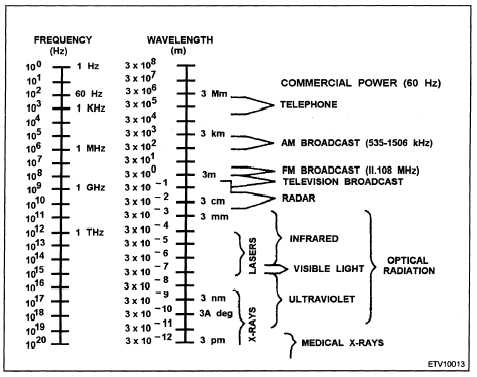to NEETS, Module 14, Introduction to Micro-
electronics.
ELECTROMAGNETIC RADIATION
HAZARDS
The electromagnetic spectrum encompasses
everyday-use items from commercial power to medical
x-rays, as shown in figure 3-2. In this area we will
discuss radio frequency radiation and optical radiation.
R-F HAZARDS TO PERSONNEL
Radiation from antennas fed by high powered rf
transmitters has the potential for injuring personnel who
happen to be near the radiating antennas. Transmitters
aboard ships, on aircraft, at shore stations, and
microwave ovens found both aboard ships and ashore
are potential sources of harmful radiation. At some
frequencies, exposure to excessive levels of rf radiation
will not produce a noticeable sensation of pain or
discomfort to give warning that injury may be
occurring. Radiated rf energy can also result in rf burns
when metal objects with induced high rf voltage levels
are touched.
An rf burn is the result of current flowing through
the body when parts of the body are in contact with rf
voltages induced in conductive objects. The current
produces heat as it passes through the resistance of the
skin. The effect of the heat on a person ranges from
warmth to painful burns.
LASER HAZARDS TO PERSONNEL
The word laser is an acronym for Light
Amplification by Stimulated Emission of Radiation. A
laser is basically a concentrated beam of optical
radiation. As technology increases, the use of laser
equipment will increase for purposes ranging from
industrial to medical to military (both offensive and
defensive).
The effects that lasers can have on your eyes range
from inflammation of the cornea to corneal burn and on
your skin from accelerated skin aging to skin burn.
If you are involved with the use of lasers at your
command, be sure to follow all safety precautions for
the class of laser in use and all directions given to you by
your command’s Laser Safety Officer. Lasers will be
discussed in greater detail in volume 9 of this series.
We recommend that you become familiar with the
contents of NAVSEA OP 3565/NAVAIR 16-1-529,
Technical Manual, Electromagnetic Radiation Hazards
(U), (Hazards to Personnel, Fuel, and Other
Flammable Material) (U). We also recommend that you
Figure 3-2.—Electromagnetic spectrum.
3 - 6


